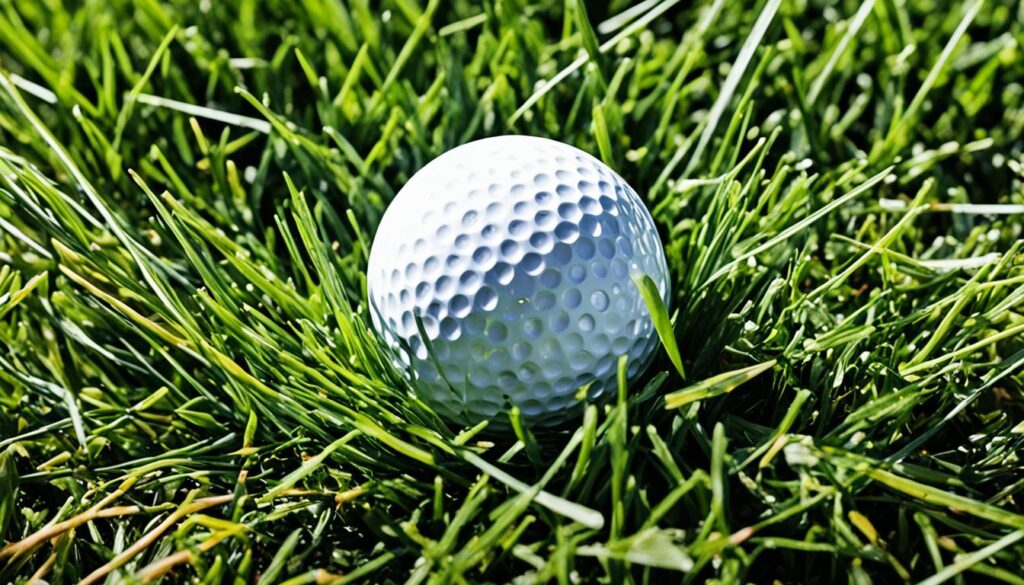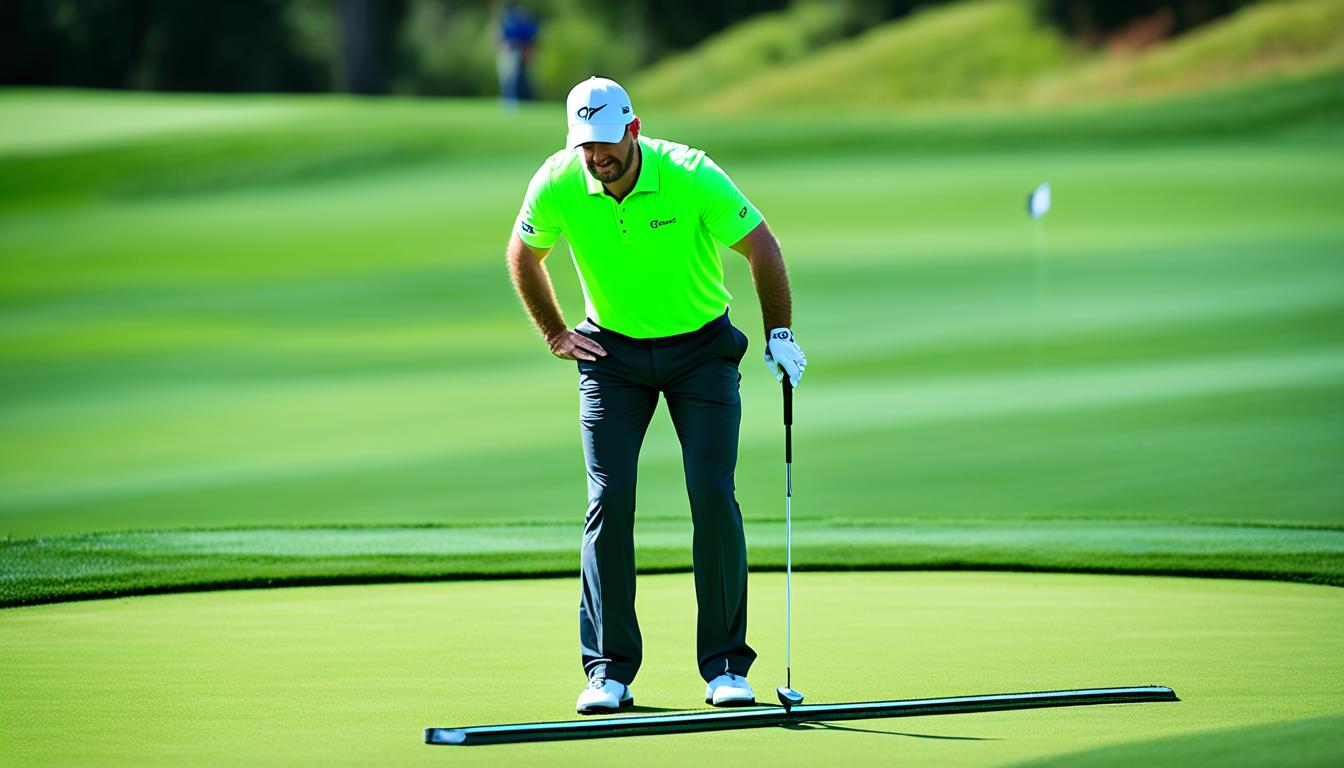Understanding golf course regulations can be tough, like a windy day on the course. Knowing the lost ball rule golf is key for golfers. If your ball is lost or out of bounds, you face a stroke and distance penalty. You must go back and play from where you last shot. This rule makes you think twice and affects your score.
According to Rule 18, the search for a lost ball starts when you or your caddie look for it. You have three minutes to find it. After that, you have to act fast. If you find the ball in time, you must quickly identify it. But, if it’s out of play, you might need to use another ball under certain rules.
It’s smart to use a provisional ball if you’re not sure where your ball landed. This can save you time and strokes. It’s a good strategy on challenging courses. These rules make sure every shot and rule helps you on the course.
Demystifying the Stroke-and-Distance Penalty
In golf, learning about penalties like the stroke and distance penalty is key. It relates to the lost ball rule golf, showing the importance of playing the course right and following golf course regulations. When a ball is lost or goes out of bounds, players must hit again from where they last played. This rule adds a big challenge.
Using a provisional ball can help keep the game moving fast and stick to the rules. If the first ball is lost or out of bounds, the player uses the provisional ball. This strategy is smart planning. Yet, sometimes things like wind or water can move the ball. Then, players can swap the ball without going back to the start. This shows how golf can adapt to surprises.
| Penalty Type | Condition | Action Required | Impact on Score |
|---|---|---|---|
| Stroke and Distance | Ball out of bounds | Replay from the spot of the previous stroke | +1 stroke |
| Provisional Ball | Original ball lost or out of bounds | Continue play with provisional ball | Depends on subsequent strokes |
| Substitution | Ball moved by external influence | Replace ball at estimated point of rest | No penalty if corrected |
Golf brings many challenges like mastering the out of bounds rules. Knowing these rules well helps players make better strategies. This is vital for playing well in competitions and enjoying the game.
The Definition and Implications of a Lost Ball on the Course
In golf, the lost ball rule is key to keeping the game fair and quick. It helps identify and find balls that players lose. This makes sure everyone knows what to do if their ball goes off course.

When a ball is hit and might be lost outside a penalty area or the bounds, players get three minutes to look for it. If not found in time, the stroke and distance penalty applies. The player has to go back and take another shot from where the last one was made, with an added penalty stroke.
Using a provisional ball is also a key tactic. If players think their ball might be lost or out of bounds, they can play another ball instead. This saves time as it avoids going back if the first ball can’t be found.
- Ball Search Time: Just three minutes to keep the game moving fast.
- Provisional Ball: Keeps the game going without stops.
- Stroke and Distance Penalty: Stops players from gaining an edge from a bad shot.
The lost ball rule helps keep the game of golf honest and stop delays. It makes golf course regulations work well for everyone.
Procedural Steps: Identifying and Dealing with a Lost Ball
When a golfer loses a ball, knowing the golf course regulations is key. The stroke and distance penalty rule lets you use a provisional ball. This is if the original ball is lost outside a penalty area or out of bounds. This quick action keeps the game fair and moving smoothly.
Ball identification is crucial for handling lost balls well. Golfers should mark their balls to avoid mix-ups. This helps figure out which ball belongs to whom within the search limit. 
In 2019, the lost ball rule golf updated with the Local Rule E-5. This rule gives an option besides the usual penalty. Golfers can play from a special drop area with a two-stroke penalty. It was made to make the game faster and more fun.
| Year | Improvement in Pace of Play | Average Balls Found per Round | Max Search Time |
|---|---|---|---|
| Pre-2019 | Slower due to backtracking | Varies | 5 minutes |
| Post-2019 | Faster with Local Rule E-5 | At least 1 | 3 minutes |
The Model Local Rule E-5 makes finding lost balls faster and less annoying. It’s great for casual games. It’s part of newer golf course regulations to make play speedier and more enjoyable.
For new or seasoned golfers, knowing these steps is important. It helps you deal with lost balls the right way. It keeps the game fair, following golf course regulations.
Understanding Out of Bounds Situations in Golf
In golf, hitting the ball with accuracy is key, but out of bounds rules can be tough for players. When a ball goes past the defined course boundaries, it’s out of bounds. This leads to penalties that require hitting the ball again from the previous spot, plus an extra penalty stroke. These rules highlight golf’s commitment to tradition since its early days in 1744, upheld by the USGA and the R&A.
Golf’s current rules about out of bounds or lost balls focus on quick and practical play. If a ball isn’t found in three minutes, it’s considered lost. Using a provisional ball helps players move on without waiting, fitting the rule for lost balls in golf. Since 2019, the USGA lets golfers drop the ball in the fairway for a two-stroke penalty, adjusting to players’ needs in a more relaxed game setting.
This aspect of golf is about balance. It keeps the challenge alive while fitting the needs of recreational golfers. From water to lateral hazards or balls going off-limits, knowing these rules is crucial. And though the rules might change, their core purpose stays the same. Richard S. Tufts noted this: playing the game fairly and with integrity is what matters most.


